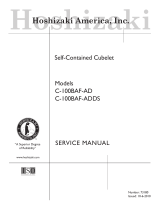
16
9) Ice Purge Cycle – "GM" LED is on. 5-sec. GM delay timer and 30-min. freeze timer
start. WV de-energizes and "WTRIN" LED turns off. Once the 5-sec. GM delay timer
terminates, GM, CCR, and EH (if applicable) energize. CCR cannot energize unless
GM circuit is complete (GM external protector and GM internal protector). Once CCR
energizes, CB K9 #5 W/O and CB K9 #6 W/O 5VDC circuit closes and ice purge timer
starts (1-min. or 5-min.). See "II.C.2a)c) Compressor Control Relay (CCR)." If CCR
de-energizes, CB K9 #5 W/O and CB K9 #6 W/O circuit opens and an 8-beep alarm
occurs. See "III.B. LED Lights and Audible Alarm Safeties." Note: To bypass ice purge
cycle and go straight to freeze cycle, press the "SERVICE" button on CB after GM
energizes.
Diagnosis CB: Check that UFS closed, WV LED turned off and WV de-energized.
If UFS is closed, "WV" LED is off, and "GM" LED is off, replace CB. If "GM" LED is
on and GM is off, conrm 115VAC at CB K1 #2 (BR) to neutral (W). If 115VAC is not
present, check for loose connection from power switch. If 115VAC is present, check for
115VAC at CB K1 #3 (DCM-300/500/752 pink (P), DCM-751 dark blue (DBU)) to neutral
(W). If 115VAC is not present, replace CB.
Diagnosis GM: If 115VAC is present at CB K1 #3 (DCM-300/500/752 pink (P),
DCM-751 dark blue (DBU)) to neutral (W), check GM fuse, GM internal protector, GM
external protector, GM windings and capacitor, and GM coupling between auger and
GM.
Diagnosis CCR: See "II.C.2a)c. Compressor Control Relay." Once ice purge timer
terminates (1-min. or 5-min.) or the "SERVICE" button is pressed, freeze cycle begins.
Diagnosis EH (DCM-500/751/752): EH energizes with GM. IfEH doesn't energize
check EH continuity. Replace as needed.
10) Freeze Cycle – "COMP" LED is on. Ice purge timer terminates (1-min. or 5-min.) or the
"SERVICE" button is pressed. "COMP" LED turns on. "GM" LED remains on. Comp and
FM energize. GM, CCR, and EH (DCM-500/751/752) continue. Ice production begins
4 to 6 minutes after Comp energizes depending on ambient and water conditions.
Diagnosis Comp: Check that "COMP" LED is on and that Comp energizes. If "COMP"
LED is off, conrm ice purge timer has terminated (1-min. or 5-min.). Check for 0VDC
across CB K9 #5 (W/O) and CB K9 #6 (W/O). If 5VDC is present, CCR contacts are
open. Check for 115VAC at CCR #7 (R) to CCR #8 (W). If 115VAC is present, check
CCR continuity between CCR #3 (W/O) and CCR #5 (W/O). If open, replace CCR.
If closed and "COMP" LED remains off, replace CB. If "COMP" LED is on and Comp is
off, check for 115VAC at CB X1 brown (BR) wire to neutral (W) and CB X1 red (R) wire
to neutral (W). If 115VAC is present on CB X1 brown (BR) wire and not on CB X1 red
(R) wire, replace CB. If 115VAC is present on CB X1 red (R) wire, check Comp external
protector, motor windings, start relay, and capacitors.
Note: If CCR de-energizes, CB K9 #5 W/O and CB K9 #6 W/O circuit opens, Comp
de-energizes and an 8-beep alarm occurs. See "III.B. LED Lights and Audible Alarm
Safeties."
Diagnosis FM: If FM does not energize, check FM capacitor, motor windings, and
bearings.
























